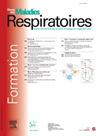Prior viral respiratory infections affect the immune response against a mouse-adapted strain of sars-cov-2 and modulate disease severity in mice
IF 0.5
4区 医学
Q4 RESPIRATORY SYSTEM
引用次数: 0
Abstract
Successive pulmonary infections shape the lung's immune landscape, influencing future immune responses to other pathogens. This phenomenon has been particularly evident in the context of SARS-CoV-2 infections, where some patients experienced only mild symptoms, while others required intensive care or succumbed to the virus. While many studies have examined the impact of comorbidities, few have explored the role of patients’ infection histories. In this study, we aimed to investigate how prior exposure to different respiratory viruses affects the pathogenesis of SARS-CoV-2 using preclinical models. Specifically, C57BL/6 mice were either pre-infected or not with a mouse-adapted strain of influenza (PR8), mouse adenovirus 1 (MAV1), Murid Herpesvirus 4 (MuHV4), or the pneumonia virus of mice (PVM). One month later, the mice were infected with a mouse-adapted strain of SARS-CoV-2 (MA30) [1]. Our findings revealed that mice pre-infected with MuHV4, MAV1, and PVM exhibited varying levels of protection against MA30 infection and disease, whereas those pre-infected with PR8 were sicker and had a lower survival rate. Using an Olink® cytokine quantification assay on bronchoalveolar lavage fluid (BALF) collected 4 and 8 days post-MA30 infection, we observed significant differences in the levels and kinetics of BALF cytokines. The most severely affected mice showed increased concentrations of pro-inflammatory cytokines, while those protected exhibited an early cytokine signature associated with protection. Additionally, these observations were linked to variations in leukocyte infiltrates, particularly myeloid cells, in the lungs. In conclusion, our results underscore that a history of respiratory virus infections dramatically influences the outcome of subsequent SARS-CoV-2 infections.
先前的病毒性呼吸道感染影响对小鼠适应的sars-cov-2株的免疫反应,并调节小鼠的疾病严重程度
连续的肺部感染塑造了肺部的免疫景观,影响未来对其他病原体的免疫反应。这种现象在SARS-CoV-2感染的情况下尤为明显,一些患者只有轻微的症状,而另一些患者则需要重症监护或死于病毒。虽然许多研究已经检查了合并症的影响,但很少有研究探索患者感染史的作用。在本研究中,我们旨在通过临床前模型研究先前暴露于不同呼吸道病毒如何影响SARS-CoV-2的发病机制。具体来说,C57BL/6小鼠分别被小鼠适应型流感病毒(PR8)、小鼠腺病毒1 (MAV1)、小鼠疱疹病毒4 (MuHV4)或小鼠肺炎病毒(PVM)预感染或未感染。一个月后,这些小鼠感染了小鼠适应的SARS-CoV-2 (MA30)[1]菌株。我们的研究结果显示,预先感染MuHV4、MAV1和PVM的小鼠对MA30感染和疾病表现出不同程度的保护,而预先感染PR8的小鼠病情更重,存活率更低。利用Olink®细胞因子定量分析ma30感染后4天和8天收集的支气管肺泡灌洗液(BALF),我们观察到BALF细胞因子的水平和动力学存在显著差异。受影响最严重的小鼠显示出促炎细胞因子浓度增加,而受保护的小鼠显示出与保护相关的早期细胞因子特征。此外,这些观察结果与肺部白细胞浸润的变化有关,特别是骨髓细胞。总之,我们的研究结果强调呼吸道病毒感染史显著影响后续SARS-CoV-2感染的结果。
本文章由计算机程序翻译,如有差异,请以英文原文为准。
求助全文
约1分钟内获得全文
求助全文
来源期刊

Revue des maladies respiratoires
医学-呼吸系统
CiteScore
1.10
自引率
16.70%
发文量
168
审稿时长
4-8 weeks
期刊介绍:
La Revue des Maladies Respiratoires est l''organe officiel d''expression scientifique de la Société de Pneumologie de Langue Française (SPLF). Il s''agit d''un média professionnel francophone, à vocation internationale et accessible ici.
La Revue des Maladies Respiratoires est un outil de formation professionnelle post-universitaire pour l''ensemble de la communauté pneumologique francophone. Elle publie sur son site différentes variétés d''articles scientifiques concernant la Pneumologie :
- Editoriaux,
- Articles originaux,
- Revues générales,
- Articles de synthèses,
- Recommandations d''experts et textes de consensus,
- Séries thématiques,
- Cas cliniques,
- Articles « images et diagnostics »,
- Fiches techniques,
- Lettres à la rédaction.
 求助内容:
求助内容: 应助结果提醒方式:
应助结果提醒方式:


